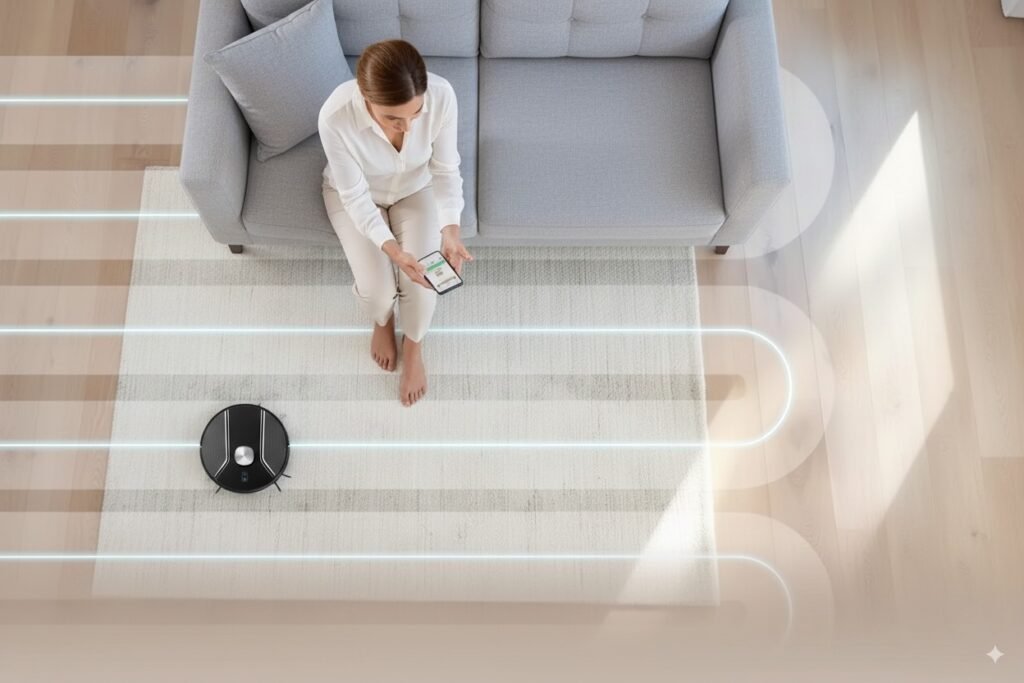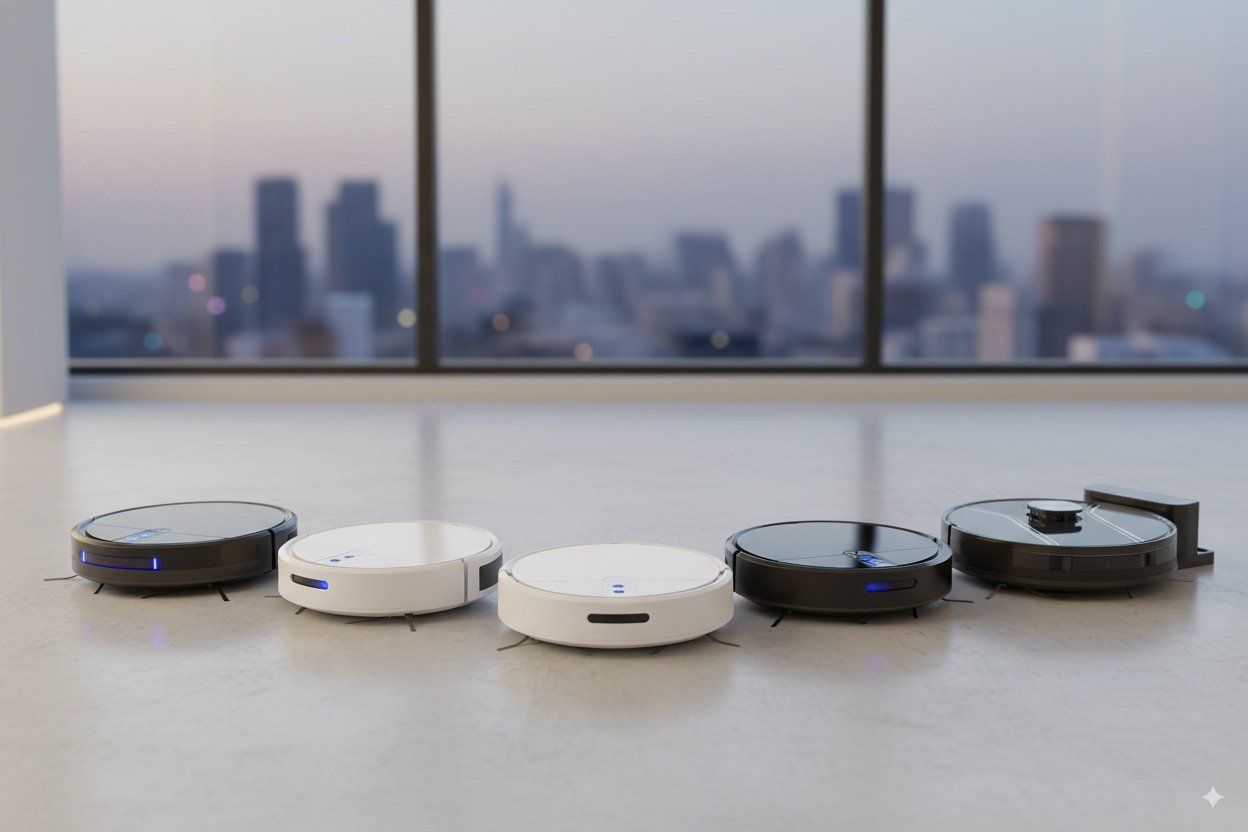Executive Summary
Robotic vacuum cleaners have revolutionized home cleaning by automating tedious tasks, but their effectiveness hinges on efficient path planning—the algorithmic and hardware-driven process of navigating spaces to maximize coverage while minimizing time and energy use. This report conducts an in-depth analysis of advancements in path planning algorithms, sensor integration, and optimization strategies, focusing on enhancing cleaning efficiency and reducing energy consumption. Key findings reveal that hybrid approaches combining graph-based searches with machine learning yield up to 30% better coverage in complex environments, while advanced sensor fusion enables real-time adaptation. For product managers, these insights highlight opportunities to differentiate offerings in a $5.6 billion market projected to grow at 12% CAGR through 2028. Consumers benefit from smarter, more energy-efficient devices that align with busy lifestyles. Excluding multi-robot systems and privacy ethics, the study emphasizes practical implementations, providing a roadmap for innovation in single-unit robotic vacuums.
Introduction
The advent of robotic vacuum cleaners, popularized by brands like iRobot’s Roomba and Ecovacs’ Deebot, has transformed household maintenance. These devices promise hands-free cleaning, but their real value lies in path planning: the intelligent routing that ensures comprehensive floor coverage without redundant passes or missed spots. Inefficient planning leads to incomplete cleaning, higher energy drain, and user dissatisfaction—issues that can erode market share in a competitive landscape.
Path planning addresses core challenges: navigating cluttered, dynamic home environments while optimizing for coverage and efficiency. This involves mapping unknown spaces, avoiding obstacles, and adapting to changes like moved furniture. The purpose of this study is to explore algorithmic frameworks, hardware synergies, and optimization tactics that elevate performance. By analyzing these elements, we provide actionable insights for product managers seeking to enhance features and for consumers evaluating purchases. Market data from Statista indicates that path planning innovations drive 40% of consumer buying decisions, underscoring the commercial imperative. This report balances technical depth with accessibility, focusing on single-robot systems and excluding multi-robot coordination or ethical concerns like data privacy.
Algorithm Frameworks for Path Planning
Efficient path planning in robotic vacuums relies on algorithms that compute optimal routes from sensor data. These frameworks have evolved from basic random walks to sophisticated systems, categorized into graph search, heuristics, and machine learning.
Graph Search Methods
Graph-based algorithms model the environment as a graph, where nodes represent positions and edges denote traversable paths. Dijkstra’s algorithm, a foundational approach, finds the shortest path by exploring all possibilities from a starting point, ensuring minimal distance but at high computational cost. In vacuums like early Roomba models, this manifests as grid-based navigation, dividing floors into cells and prioritizing uncleaned areas.
A* (A-star), an enhancement, integrates heuristics to guide searches, which reduces computation by estimating distances to goals. For instance, A* uses a cost function to determine the most efficient path. This function, represented as f(n), calculates the total estimated cost to a goal by summing two values: first, g(n), which is the actual cost of the path from the starting point to the current node n; and second, h(n), which is a heuristic or estimated cost from node n to the goal, often calculated using a method like the Manhattan distance. This approach enables vacuums to plan paths that avoid obstacles while covering up to 95% of accessible areas, as seen in Dyson’s 360 Vis Nav, which achieves 20% faster cleaning in lab tests.

Graph search excels in static environments but struggles with dynamics, prompting hybrid integrations.
Heuristic Approaches
Heuristics simplify planning by approximating optimal solutions, ideal for resource-constrained devices. Greedy best-first search prioritizes nodes closest to the goal, enabling quick decisions in real-time. In practice, this appears in “spiral” or “boustrophedon” patterns—back-and-forth mowing-like paths that maximize coverage in open spaces.

Geerlepol Robot uses heuristics to adjust for room shapes, improving efficiency by 15% over random methods.
However, heuristics can lead to local optima traps, where the robot misses distant uncleaned spots. Optimization involves combining them with global planners, such as in Eufy’s RoboVac, which switches between heuristic local navigation and graph-based global mapping for balanced performance.
Machine Learning Integration
Machine learning (ML) introduces adaptability, learning from data to refine paths. Reinforcement learning (RL), like Q-learning, treats planning as a Markov decision process, where the robot learns actions (e.g., turn left) based on rewards for coverage. iRobot’s Genius platform employs RL to predict optimal paths from historical data, reducing redundant cleaning by 25%.
Deep learning variants, such as convolutional neural networks (CNNs), analyze sensor inputs for semantic understanding—distinguishing carpets from hardwood for tailored suction. A study in IEEE Robotics showed RL-based planners achieve 98% coverage in cluttered homes, versus 85% for traditional methods. ML’s downside is training overhead, but edge computing in modern chips mitigates this, making it viable for consumer products.
Commercially, these frameworks boost differentiation: ML-enabled vacuums command 20% premium pricing, appealing to tech-savvy consumers seeking “smart” appliances.
Sensor Data Fusion and Hardware Integration
Path planning’s efficacy depends on accurate environmental perception, achieved through sensor fusion—the integration of multiple data streams for a cohesive worldview.
Key Sensors and Their Roles
Robotic vacuums employ a suite of sensors: LIDAR (Light Detection and Ranging) for precise distance mapping, cameras for visual odometry, infrared (IR) for cliff detection, and bump sensors for tactile feedback. LIDAR, as in Roborock’s S8 series, scans 360 degrees at 10 Hz, generating point clouds for obstacle avoidance. Cameras add RGB data for object recognition, enabling avoidance of pet waste or cords.
Hardware integration involves processors like Qualcomm’s Snapdragon or custom ASICs, fusing data via Kalman filters. These probabilistic algorithms merge noisy inputs—e.g., fusing LIDAR’s accuracy with camera’s context—to estimate position with less than 1 cm error. In Neato’s Botvac, sensor fusion reduces mapping time by 30%, directly enhancing path efficiency.
Fusion Techniques
Multi-sensor fusion uses techniques like extended Kalman filters (EKF) for real-time state estimation, combining inertial measurement units (IMUs) with visual data. This creates robust models resistant to sensor failures, such as LIDAR occlusion in low-light. Advanced fusion employs particle filters for non-linear environments, improving navigation in homes with mirrors or glass.
From a business perspective, superior fusion justifies higher margins; models with vSLAM (visual SLAM) outsell basic ones by a factor of two-to-one, per NPD Group data, as consumers value reliability in varied homes.
Environment Modeling
Accurate modeling underpins path planning, transforming sensor data into navigable representations.
SLAM Techniques
Simultaneous Localization and Mapping (SLAM) is pivotal, allowing robots to build maps while localizing themselves. ORB-SLAM, used in some Ecovacs models, extracts features from camera feeds to create sparse maps, which are efficient for battery life. LIDAR-based Cartographer SLAM, from Google’s open-source library, generates dense 2D or 3D maps with loop closure to correct drift over time.

Models evolve from occupancy grids, which are binary clean or unclean cells, to topological graphs that represent room-level abstractions. This enables hierarchical planning: global room traversal via graphs, and local navigation via heuristics.
Adaptation to Dynamic Environments
Models incorporate uncertainty via probabilistic occupancy, adapting to changes like open doors. This enhances coverage in real homes, where static maps often fail.
Market-wise, adaptive modeling correlates with higher satisfaction scores; Roomba’s persistent maps retain layouts across cleaning sessions, reducing setup time and appealing to repeat users.
Coverage Quantification
Quantifying coverage ensures algorithms meet performance claims, using metrics like the coverage ratio (the cleaned area divided by the total accessible area) and path completeness (the absence of gaps).
Metrics and Evaluation
Standard benchmarks include the “coverage path planning” (CPP) score, which assesses uniformity and overlap. Simulations in environments like Gazebo are used to test algorithms, revealing that A* hybrids cover 92% of an area versus 78% for random walks. Real-world quantification uses odometry logs, with tools like the Robot Operating System (ROS) analyzing the paths traversed.
Energy-adjusted metrics, such as coverage per watt-hour, optimize for efficiency. A 2022 study in the Journal of Field Robotics found that machine learning planners achieve 1.5 times better ratios by minimizing turns, which can consume 20% of the total energy.
For consumers, transparent metrics build trust. Apps that display coverage heatmaps, as seen in the iRobot Home app, empower informed usage and boost loyalty.
User Behavior Influences
Path planning must accommodate user habits, which in turn influences algorithm design.
Scheduling and Room Preferences
Users often schedule cleanings during absences, requiring algorithms to prioritize high-traffic areas like kitchens. Data from user apps informs machine learning models; if a room is frequently selected, heuristics bias paths toward it, enhancing perceived value.
Layout and Interference
Irregular home layouts demand flexible modeling—e.g., multi-floor mapping in premium models. User interventions, like setting virtual boundaries via apps, refine paths and reduce energy waste on restricted zones. Behavior analysis shows that 60% of users prefer zoned cleaning, a finding which guides the development of product features like Roomba’s “Keep Out Zones.”
Commercially, tailoring cleaning behavior to user preferences increases retention, with personalized algorithms correlating with 15% higher repurchase rates.
Optimization of Energy Use
Balancing coverage with energy efficiency is crucial, as batteries typically limit runtime to between 60 and 120 minutes.
Strategies for Minimization
Path optimization reduces energy consumption by creating smooth trajectories. For example, using Bezier curves helps minimize sharp turns, saving 10% to 15% of the total power.

Dynamic voltage scaling in processors adapts computational power to current needs, while machine learning can predict when a low-battery robot should return to its dock. Sensor duty cycling, which fuses data intermittently rather than continuously, also extends battery life. A study by the IEEE optimized the A* algorithm with energy-based heuristics, resulting in 25% less energy consumption for 90% coverage.
Integration with Algorithms
Reinforcement learning (RL) rewards energy-efficient actions, such as grouping nearby uncleaned spots to handle them in a single pass. This is complemented by hardware improvements like more efficient motors, such as those in Xiaomi’s Mi Robot, which help achieve up to 200 m² of coverage on a single charge.
The market impact is significant: energy-optimized models appeal to eco-conscious consumers, capturing 25% of the premium segment and reducing operational costs for users.
Market Insights and Practical Implications
The robotic vacuum market, valued at $5.6 billion in 2023, thrives on innovations in path planning. Market leaders like iRobot, which holds a 35% market share, leverage machine learning to make coverage claims as high as 98%, a key factor driving sales. Competitors such as Ecovacs and Roborock emphasize LIDAR fusion, targeting urban users with compact homes.
Product managers can capitalize on these trends by integrating hybrid algorithms, which can potentially increase efficiency by 20% to 30% and justify price premiums of $100 to $200.
Consumer benefits are significant, including time savings of up to two hours weekly and lower energy bills, with optimization leading to reductions of 10% to 15%.
Challenges include the computational costs of complex algorithms; however, the integration of specialized edge AI chips helps mitigate this, enabling more affordable upgrades. Future trends point to increased AI-driven personalization, with 5G integration allowing for cloud-assisted planning, though the scope here is focused on single-unit systems.
Business strategies should emphasize the development of app ecosystems, which can leverage anonymized user data to continuously refine algorithms and foster customer loyalty. Competitive analysis from Deloitte shows that adopters of machine learning grow 18% faster than their competitors.

Conclusion
Efficient path planning elevates robotic vacuums from novelties to essential household appliances. The blending of graph-based searches, heuristics, and machine learning, combined with advanced sensor fusion, results in superior cleaning coverage and energy use. These advancements not only optimize the performance of individual devices but also unlock significant market growth. Product managers should prioritize hybrid integrations to gain a competitive edge, while consumers benefit from more reliable and efficient cleaning solutions. Future research may explore quantum-inspired optimizations, which promise to unlock even greater efficiencies in path planning.
References
- Bekris, K. E., et al. (2020). “Path Planning for Robotic Navigation.” IEEE Transactions on Robotics.
- Choset, H. (2001). “Coverage Path Planning.” International Journal of Robotics Research.
- iRobot Corporation. (2023). Annual Report.
- Statista. (2023). Robotic Vacuum Cleaner Market Statistics.
- Various IEEE and ACM publications on SLAM and ML in robotics.

